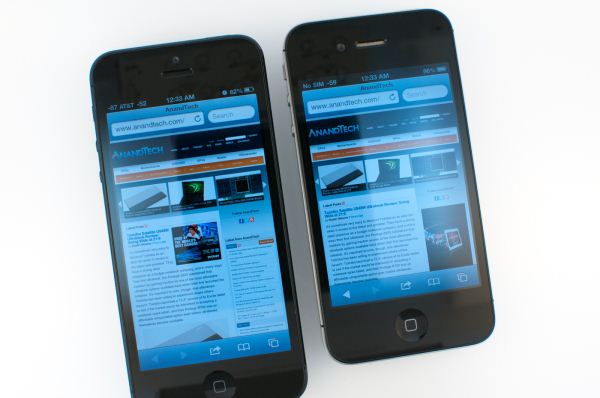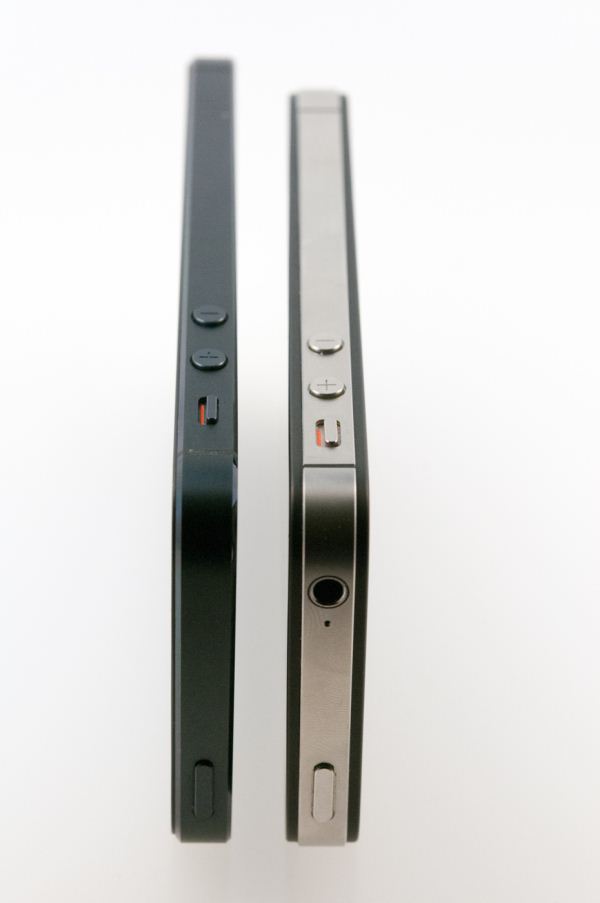The iPhone 5 Review
by Anand Lal Shimpi, Brian Klug & Vivek Gowri on October 16, 2012 11:33 AM EST- Posted in
- Smartphones
- Apple
- Mobile
- iPhone 5
The last significant redesign of the iPhone platform came in 2010 with the iPhone 4. It was an update that literally touched all aspects of the device, from SoC to display to baseband and of course, chassis. Last month’s launch of the iPhone 5 is no different in magnitude. The sixth generation iPhone makes some of the biggest changes to the platform since its introduction in 2007.
Visually the device begins by evolving the design language of the iPhone 4/4S chassis. From the launch of the iPhone 4 it was quite obvious that Apple had picked a design it was quite proud of. Thus it’s not too surprising that, from a distance, the iPhone 5 resembles the previous two iPhone models. We’ll get into material differences shortly, but what make the iPhone 5 design such a radical departure is its larger display.
All previous iPhones have maintained the same 3.5-inch, 3:2 aspect ratio display. With the rest of the world quickly moving to much larger displays, and with 16:9 the clear aspect ratio of choice, when faced with the decision of modernizing the iPhone platform the choice was obvious.
The iPhone 5 embraces a taller, 4-inch, 16:9 1136 x 640 display opting to lengthen the device instead of increasing its area in both dimensions. The result is a device that is distinctly an iPhone, albeit a modern one. The taller display doesn’t do much to make desktop web pages any easier to read as a result of the width staying the same. Those longing for an HTC One X or Galaxy S 3 sized device running iOS are out of luck. Reading emails and typing are both improved though as there’s now more room for lists and the keyboard no longer occupies as much of the display. The taller device can be more awkward to use if you have smaller hands, but the added screen real estate is honestly worth it. Once you get used to the iPhone 5’s display, going back to the older models is tough.
The taller chassis went on a diet as well. The iPhone 5 is now considerably thinner and lighter than its predecessor, which is yet another factor that contributes to it feeling more modern.
Internally the device changes are just as significant, if not more, than those on the outside. The iPhone 5 includes LTE support, which in areas where LTE networks are deployed can be enough reason alone to warrant an upgrade.
The iPhone 5 also includes a brand new SoC from Apple: the A6. For the first time since the introduction of the iPad, Apple has introduced a major branded SoC on an iPhone first. The iPhone 4 used the A4 after it debuted on the iPad, and the 4S picked up the A5 months after the iPad 2 launched with it. The A6 however arrives first on the iPhone 5, and with it comes two of Apple’s first, custom designed CPU cores. We’ve always known Apple as a vertically integrated device and software vendor, but getting into CPU design takes that to a new level.
| Physical Comparison | ||||
| Apple iPhone 4S | Samsung Galaxy S 3 (USA) | HTC One S | Apple iPhone 5 | |
| Height | 115.2 mm (4.5") | 136.6 mm (5.38" ) | 130.9 mm (5.15" ) | 123.8 mm (4.87") |
| Width | 58.6 mm (2.31") | 70.6 mm (2.78") | 65 mm (2.56") | 58.6 mm (2.31") |
| Depth | 9.3 mm ( 0.37") | 8.6 mm (0.34") | 7.8 mm (0.31") | 7.6 mm (0.30") |
| Weight | 140 g (4.9 oz) | 133g (4.7 oz) | 119.5g (4.21 oz) | 112 g (3.95 oz) |
| CPU | Apple A5 @ ~800MHz Dual Core Cortex A9 | 1.5 GHz MSM8960 Dual Core Krait | 1.5 GHz MSM8260A Dual Core Krait | 1.3 GHz Apple A6 (Dual Core Apple Swift) |
| GPU | PowerVR SGX 543MP2 | Adreno 225 | Adreno 225 | PowerVR SGX 543MP3 |
| RAM | 512MB LPDDR2-800 | 2 GB LPDDR2 | 1 GB LPDDR2 | 1 GB LPDDR2 |
| NAND | 16GB, 32GB or 64GB integrated | 16/32 GB NAND with up to 64 GB microSDXC | 16 GB NAND | 16, 32, or 64 GB integrated |
| Camera | 8 MP with LED Flash + Front Facing Camera | 8 MP with LED Flash + 1.9 MP front facing | 8 MP with LED Flash + VGA front facing | 8 MP with LED Flash + 1.2MP front facing |
| Screen | 3.5" 960 x 640 LED backlit LCD | 4.8" 1280x720 HD SAMOLED | 4.3" 960x540 Super AMOLED | 4" 1136 x 640 LED backlit LCD |
| Battery | Internal 5.3 Whr | Removable 7.98 Whr | Removable 6.1 Whr | Internal 5.45 Whr |
There’s a lot to talk about when it comes to the new iPhone. Whether it is understanding the architecture of the A6 SoC or investigating the improved low light performance of the iPhone 5’s rear facing camera, we’ve got it here in what is easily our most in-depth iPhone review to date. Let’s get started.












276 Comments
View All Comments
TrackSmart - Wednesday, October 17, 2012 - link
Shouldn't the battery life on the Verizon Galaxy SIII with LTE be higher than shown? That result bunches up with the 3G scores rather than the LTE scores. I wonder if the "LTE" listing is a typo.It's also a bit surprising how much of a difference the connection speed makes (3G vs 4G LTE) for the battery life tests. Are you guys really testing differences in power efficiency under typical use? Or have you, inadvertently, created a strange test of air interface throughput/watt - which would vary based on signal strength and network speed, but not based on the main device power draw under typical browsing (i.e. screen + intermittent CPU usage spikes).
I would have guessed that that screen power draw would be the largest cause for differences between handsets, not the air interfaces on the new devices, now that LTE is no longer a power hog.
phillyry - Sunday, October 21, 2012 - link
If it's anything like the Telus GS3 up here in Canada than it's not likely a typo. My brother has it and it tanks so bad on LTE that he keeps it turned off. Same thing with NFC btw. Two major selling features of the GS3 that went down the tubes in reality.Skidmarks - Wednesday, October 17, 2012 - link
I've got to hand it to Apple, if nothing else they sure know to market their rubbish.Freakie - Wednesday, October 17, 2012 - link
I haven't seen the 5 in person, but every time I see a picture of the front of it, I swear its design echos Samsung devices quite a bit. If any light hits it directly then it looks off-black, at least in the pictures, to the point of looking like Samsung's Pebble Blue color back when it was a bit darker (Samsung Impression).They got rid of the band around the phone and just have a slanted surface which when looking at pictures taken 8 inches away from the phone, has it's sharp "edges" that it slants to become one smooth transition. Reminds me a lot of the GSII's front.
Now I'm not a fan of any design litigations going either way, but I've never seen a Samsung device echo the looks of Apple's devices quite as much as the iPhone 5 echos a number of Samsung's design flairs that they've been using for a while.
Just my two cents xP
kmmatney - Wednesday, October 17, 2012 - link
Are you kidding me. Look at how much the original; Samsung Galaxy copies the iPhone 3G. Same with the Galaxy SII.See for yourself
3G versus SGI
https://encrypted-tbn1.gstatic.com/images?q=tbn:AN...
and 4S versus SGII
http://www.gizmowatch.com/entry/comparing-mights-i...
medi01 - Wednesday, October 17, 2012 - link
Wow, SGII and 4S have the same screen ratio, you shameless iScum...Freakie - Wednesday, October 17, 2012 - link
Oh I never said that Samsung hasn't produced a phone similar to an iPhone, though your second picture is pretty ridiculous (that's the SGI not SGII) which came out several months before the 4. Not only that but the picture its self is most definitely shot/edited in a way to make them as similar as possible.My complaint is just Apple doing something very different than normal, and echoing someone else for a change. Usually they seem to go for something different than the rest and the iPhone 5 most definitely does not come anywhere near that.
steven75 - Wednesday, October 17, 2012 - link
This is probably the most silly comment I've read among any iPhone reviews. iPhones have always been similar overall since the revolution if 2007 and now you are seriously making the claim this looks more like a Samsung device?/smh
MNSoils - Wednesday, October 17, 2012 - link
Apple has an interesting story here and your group did a wonderful job telling it.On the 2 graph of the "Increased Dynamic Range" page, the idle power for the Tegra 3 SOC after finishing the Kraken benchmark seems awfully high for just the companion core. Does more time have to elapse before Android reverts to the companion core? Is the companion core not that power efficient (power-gated, etc.)? Does Android revert to the companion core?
colonelclaw - Wednesday, October 17, 2012 - link
Thanks for a terrific article. It's just a shame that about 75% of the comments will be by people who either love the device or hate it, and nothing in this carefully researched and written appraisal will make them change their minds either way.How did we get to this? Actually, don't answer, that would turn into an irrelevant pissing match too.